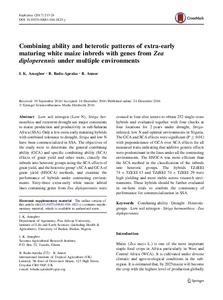| dc.contributor.author | Amegbor, I.K. |
| dc.contributor.author | Badu-Apraku, B. |
| dc.contributor.author | Annor, B. |
| dc.date.accessioned | 2019-12-04T11:07:47Z |
| dc.date.available | 2019-12-04T11:07:47Z |
| dc.date.issued | 2017-01 |
| dc.identifier.citation | Amegbor, I.K., Badu-Apraku, B. & Annor, B. (2017). Combining ability and heterotic patterns of extra-early maturing white maize inbreds with genes from Zea diploperennis under multiple environments. Euphytica, 213(24), 1-16. |
| dc.identifier.issn | 0014-2336 |
| dc.identifier.uri | https://hdl.handle.net/20.500.12478/1588 |
| dc.description | Published: online 24 December 2016 |
| dc.description.abstract | Low soil nitrogen (Low N), Striga hermonthica and recurrent drought are major constraints to maize production and productivity in sub-Saharan Africa (SSA). Only a few extra-early maturing hybrids with combined tolerance to drought, Striga and low N have been commercialized in SSA. The objectives of the study were to determine the general combining ability (GCA) and specific combining ability (SCA) effects of grain yield and other traits, classify the inbreds into heterotic groups using the SCA effects of grain yield, and the heterotic group’s SCA and GCA of grain yield (HSGCA) methods, and examine the performance of hybrids under contrasting environments. Sixty-three extra-early white maize inbred lines containing genes from Zea diploperennis were crossed to four elite testers to obtain 252 single-cross hybrids and evaluated together with four checks at four locations for 2 years under drought, Striga-infested, low N and optimal environments in Nigeria. The GCA and SCA effects were significant (P ≤ 0.01) with preponderance of GCA over SCA effects for all measured traits indicating that additive genetic effects were predominant in the lines under all the contrasting environments. The HSGCA was more efficient than the SCA method in the classification of the inbreds into heterotic groups. The hybrids TZdEEI 74 × TZEEI 13 and TZdEEI 74 × TZEEI 29 were high yielding and most stable across research environments. These hybrids should be further evaluated in on-farm trials to confirm the consistency of performance for commercialization in SSA. |
| dc.description.sponsorship | African Union |
| dc.format.extent | 1-16 |
| dc.language.iso | en |
| dc.subject | Combining Ability |
| dc.subject | Drought |
| dc.subject | Striga Hermonthica |
| dc.subject | Zea Diploperennis |
| dc.subject | Heterotic Groups |
| dc.subject | Low Soil Nitrogen |
| dc.subject | White Maize Inbreds |
| dc.subject | Genomic Resources |
| dc.title | Combining ability and heterotic patterns of extra-early maturing white maize inbreds with genes from Zea diploperennis under multiple environments |
| dc.type | Journal Article |
| dc.description.version | Peer Review |
| cg.contributor.crp | Maize |
| cg.contributor.affiliation | University of Ibadan |
| cg.contributor.affiliation | Savanna Agricultural Research Institute, Ghana |
| cg.contributor.affiliation | International Institute of Tropical Agriculture |
| cg.coverage.region | Africa |
| cg.coverage.region | West Africa |
| cg.coverage.country | Nigeria |
| cg.researchtheme | BIOTECH & PLANT BREEDING |
| cg.isijournal | ISI Journal |
| cg.authorship.types | CGIAR and developing country institute |
| cg.iitasubject | Maize |
| cg.iitasubject | Plant Breeding |
| cg.iitasubject | Plant Genetic Resources |
| cg.iitasubject | Soil Fertility |
| cg.journal | Euphytica |
| cg.howpublished | Formally Published |
| cg.accessibilitystatus | Limited Access |
| local.dspaceid | 82270 |
| cg.targetaudience | Scientists |
| cg.identifier.doi | http://dx.doi.org/10.1007/s10681-016-1823-y |

